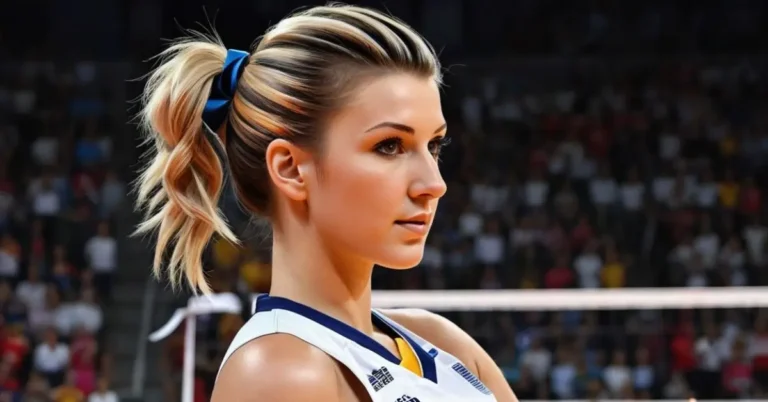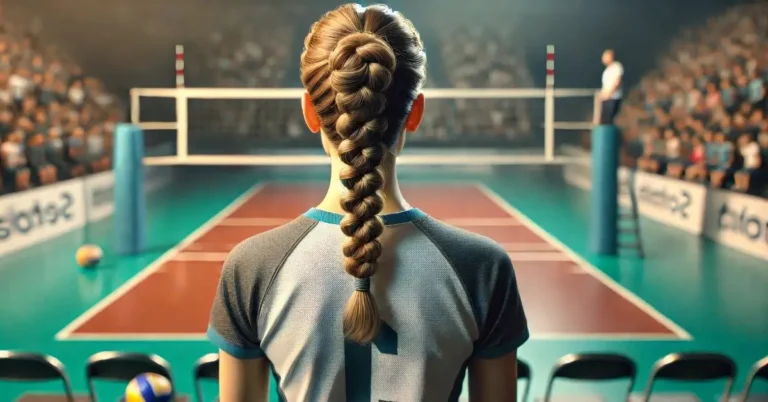Have you ever encountered superior blockers in the opposing team, facing a wall of arms and hands? Then you know exactly how effective excellent blockers can be for the success of their team.
As blocking has such an impact on the outcome of a match block drills for volleyball are an indispensable element of our training routine. We incorporate a variety of volleyball blocking drills into our sessions to sharpen our reflexes and build our defensive strategies.
Fundamentals of Blocking
Mastering block drills for volleyball is essential for us to elevate our game. Blocking is not just about jumping high; it’s about timing, technique, and strategy.
Blocking Technique
Blocking effectively hinges on our ability to anticipate the hitter’s move and position our hands correctly. As blockers, we aim to reach over the net with our hands to form a “roof” that funnels the ball back onto the opponent’s side. It’s imperative to keep our hands strong and pressed, angling them towards the area we want the ball to go. Picture the hand position: the palms should face the sky and the fingers should spread wide to cover maximum space. One of the key elements to a successful block is the timing of our jump; we jump after the hitter has committed to their swing to increase our chances of shutting down the attack.
Footwork Fundamentals
The foundation of blocking is basic footwork. A traditional block involves three steps: a small step with the lead foot followed by a larger crossover step with the other foot, and then bringing the first foot alongside the second. This sequence, sometimes referred to as a shuffle-step or slide-step, allows for lateral movement along the net and should be executed smoothly to ensure we can jump high and maintain balance. Proper footwork ensures that we are always in the best possible position to make a block. Our focus never strays from the ball, allowing us to adjust our footwork quickly as the ball travels across the net.
Remember, our presence at the net is a powerful deterrent. By refining our block drills for volleyball, we can significantly disrupt the opposing team’s offense and shift the momentum in our favor.
Advanced Block Drills for Volleyball
Mastering the block drills for volleyball is crucial for shutting down opponents and can be the pivotal difference in tight matches. It’s not just about leaping high; it’s about timing, endurance, and technique. Now, let’s dive into some complex drills that can refine your team’s defensive prowess at the net.
Mirror Blocking Drills
In Mirror Blocking Drills, partners work in sync, focusing on the significance of timing and reading the attacker’s movements. One player acts as the attacker while the other mimics their moves as the blocker, without the ball being used. It’s like dancing at the net, where one leads and the other follows, sharpening reflexes and mirroring skills. These drills are a staple in our training routine, and they’re essential for developing that instinctual block that can change the course of a game.
5 Volleyball Block Drills for Volleyball
The 5 Volleyball Blocking Drills are tailored to cultivate a team’s blocking technique and endurance. These drills include exercises like “Block, Reset, Fall Back,” where players practice not only the block but also how to land and immediately get ready for the next play. Another key drill might involve players moving laterally along the net to block balls in a sequence, which mimics the unpredictability of actual match scenarios. Each drill is designed to replicate match conditions, helping players build the muscle memory and stamina needed for successful blocks.
By integrating these advanced blocking drills into your practice sessions, your team’s defensive net play will become a formidable force that can dominate the game.
Team Blocking Strategies
Mastering block drills for volleyball is essential for our team to dominate the net and shut down our opponents. Effective team blocking involves a blend of reliable communication, impeccable timing, and strategic positioning.

Communication and Timing
Let’s talk about communication on the court—this is the backbone of a strong defense. We always ensure our middle blockers and outside hitters are in sync. Verbal cues allow us to set up a double or triple block quickly, adjusting to where the ball is being hit. Imagine this: the setter on the opposing team sends the ball toward their outside hitter. One of our middle blockers shouts, “Outside!” and our players swiftly align to form a double block, poised and ready.
Positioning and Formations
Our positioning and formations depend heavily on the hitters we’re up against. Here’s our approach:
- Middle Blockers: These key players take charge of the net. They read the set and react, moving laterally across the net to join outside hitters and close the block.
- Outside Hitters: They focus on penetrating the net and turning the hands towards the court to channel the ball down. In a triple block, the opposite hitter joins to cover more area.
We drill various formations to ensure we’re prepared for any offensive strategy. During block drills for volleyball, formations such as the “swing blocking” technique involve our blockers adjusting their footwork to cover the court efficiently and effectively. Remember, it’s all about that disciplined formation that turns our defense into an impenetrable force.
Individual Skill Enhancement
To excel in volleyball, we must focus on refining our personal abilities. Let’s dive into how setter engagement and optimizing our jump and reach through block drills for volleyball can significantly advance our game.
Setter Engagement
Working closely with the setter is crucial for successful offense. We can practice setting drills that involve a quick transition to blocking. For instance, after setting the ball, rapidly transition to a blocking position, preparing for a counter-hit. This enhances our agility and readiness.
Improving Jump and Reach
To improve our hitting prowess, we focus on drills that enhance our jump and reach. Here’s a simple but effective drill:
- Vertical Leap Practice: Begin with feet shoulder-width apart near the net.
- Quickly squat and explode upwards, extending arms to mimic a block.
- Aim to jump high, touching a marker or the volleyball net.
Through repetitive practice, we aim to condition our muscles to maximize our jump height, which is pivotal in dominating the net on defense.
In addition to conditioning our legs, we can use Volleyball Explorer’s guide to single-block drills to fine-tune our timing and coordination, ensuring that we reach as high and effectively as possible when facing an oncoming hit.
Practical Game Application
As we dive into the game application of block drills for volleyball, remember that success hinges on the seamless integration of these drills into live gameplay. It’s our chance to transform practice into real game-changing defense. Let’s explore how reading the opponent and performing blocks within a game context are crucial for our middle and outside hitters to effectively shut down the attack.
Reading the Opponent
One of the most vital skills we can foster in our blockers is the ability to read the opponent. Defense starts with observation. By honing our visual skills, we can anticipate an outside hitter’s moves. Pay attention to the opponent’s formation and approach; are they preparing for a powerful hit or a strategic tip? Our middle hitter then positions themselves, ready to react, whether it’s to block the angle or the line. By effectively reading the cues, our blockers can make split-second decisions that could turn the tide in our favor.
- Visual Cues to Watch For:
- Setter’s hand position and movement
- Hitter’s approach and body orientation
- Strategies for Blockers:
- Adjust position based on anticipated hitting angle
- Jump timing to match hitter’s attack
Blocking in a Game Context
In the thick of a match, applying our block drills for volleyball is about more than just reaching over the net. It’s a strategic move that involves teamwork and understanding the flow of the game. Our blockers must work in unison with the defense behind them. When our middle hitter blocks, they must also consider the defense’s ability to cover the area around the block. It’s a coordinated effort to not only attempt to block the ball but to funnel it into a zone our defense can control.
- Game Context Considerations:
- Blocker’s coordination with back row defense
- Adjusting block based on hitter’s tendencies and the set quality
Through practice and dedication to these aspects of blocking, our team can enhance our on-court performance. By applying block drills for volleyball in these specific contexts, we’re building a formidable defense that can adapt and overcome any offensive strategy deployed by our opponents.
FAQs
Mastering block drills for volleyball is essential for turning defense into offense. We’ve compiled commonly asked questions to help us fine-tune our blocking skills.
How do you practice volleyball blocking?
To practice blocking, we engage in drills that focus on footwork, timing, and jump technique. Drills like the Flying Ace, which involves moving swiftly across the net to block, can greatly enhance our lateral movement and reaction speed.
How do you block perfectly in volleyball?
Perfect blocks require excellent timing and technique. We start with the basics of blocking: initiating a strong, balanced jump, positioning our hands to take up maximum space above the net, and aiming to direct the ball downwards on the opponent’s side. Consistent practice with focused drills like Seniors Block can improve our precision.
How do you get more blocks in volleyball?
Increasing our block count hinges on anticipation and reading the play. We improve our chances by studying opposing hitters’ tendencies and sharpening our reflexes with repetitive drills. Drills like Run, Forrest, Run! help us recognize where the ball is going and be in the right position to execute a block.
What is the skill of blocking in volleyball?
Blocking is a defensive skill that involves intercepting the ball just as it comes over the net to prevent an opponent’s attack from landing in our court. It’s a blend of physical ability—like jumping and reach—and mental acuity, such as anticipating hitters’ moves and being aware of the overall flow of the game.
We hope you could find some valuable input about block drills for volleyball. We would be curious about your experience: How do your block drills for volleyball look like? How did you become a good blocker? Let us know in the comments.
If you liked this article you might also like to dive a little bit deeper into our articles about tryout-drills or ball control drills.





